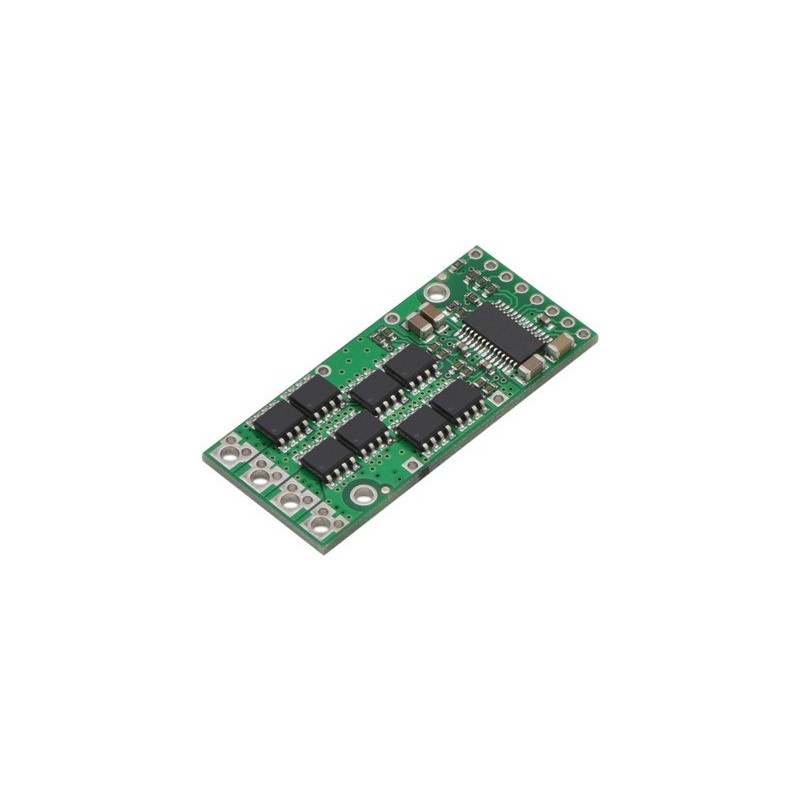



179,91 zł Netto
Pololu wysokoprądowy sterownik silnika umożliwia sterowanie silnikami DC o dużym poborze prądu w systemach do 40 V. Moduł sprawdza się w projektach wymagających wysokiej wydajności prądowej, prostego interfejsu sterowania oraz kompaktowej konstrukcji, przy zachowaniu elastyczności w doborze chłodzenia i zabezpieczeń. Pololu 759
Pololu High-Power Motor Driver 24v20 przeznaczony do dwukierunkowego sterowania jednym szczotkowym silnikiem prądu stałego o dużej mocy. Moduł oparty na dyskretnym mostku H z tranzystorami MOSFET typu N obsługuje szeroki zakres napięcia zasilania od 5,5 V do 40 V, co umożliwia zastosowanie w systemach 12 V, 24 V oraz innych instalacjach o podwyższonym napięciu.
Kompaktowa płytka o wymiarach 1,8 × 0,8 cala umożliwia dostarczanie do 20 A prądu ciągłego bez radiatora, a przy zastosowaniu dodatkowego chłodzenia nawet do około 28 A. Sterownik obsługuje tryby sign-magnitude oraz locked-antiphase, wymagając minimalnie dwóch linii sterujących (PWM i DIR), co upraszcza integrację z mikrokontrolerami i systemami sterowania.
Układ oferuje detekcję zwarć, spadków napięcia oraz przegrzania, sygnalizowanych na wyjściach FF1 i FF2. Moduł nie posiada sprzętowych zabezpieczeń nadprądowych ani temperaturowych, dlatego w aplikacjach pracujących blisko granic parametrów zalecane pozostaje stosowanie zewnętrznego pomiaru prądu oraz odpowiedniego chłodzenia. Rozwiązanie sprawdza się w robotach mobilnych, napędach o dużej mocy, platformach badawczych i projektach prototypowych.
Cechy
Producent BTC Korporacja sp. z o. o. Lwowska 5 05-120 Legionowo Polska sprzedaz@kamami.pl 22 767 36 20
Osoba odpowiedzialna BTC Korporacja sp. z o. o. Lwowska 5 05-120 Legionowo Polska sprzedaz@kamami.pl 22 767 36 20
Nakładka przeznaczona do użycia z płytkimi z serii Feather zawiera dwa układy TB6612 pozwalające na sterowanie silnikami prądu stałego lub silnikami krokowymi. Do komunikacji z nakładką wykorzystywany jest interfejs I2C. Adafruit 2927
Sterownik silnika prądu stałego (DC) o napięciu pracy 6,5-30V i maksymalnym prądzie ciągłym 19A. Posiada możliwość łatwej realizacji pętli sprzężenia zwrotnego oraz liczne interfejsy sterujące. Pololu 3146
Sterownik silników krokowych, który może pracować z napięciem z zakresu od 20 do 50 V oraz maksymalnym prądem do 4,2 A. Umożliwia konfigurację mikrokroku w zakresie od 2 do 128. DM542
Kompaktowy i wydajny moduł przeznaczony do precyzyjnego sterowania bipolarnymi silnikami krokowymi, oferujący mikrostepping do 1/32 kroku oraz maksymalny prąd do 2 A w trybie szczytowym. Dzięki zaawansowanym funkcjom, takim jak algorytm QuietStep (APFD), wbudowane zabezpieczenia oraz kompatybilność pinowa z A4988, doskonale sprawdzi się w projektach hobbystycznych, edukacyjnych i przemysłowych. Wersja Blue Edition z czterowarstwową płytką i miedzią 2 oz zapewnia lepsze odprowadzanie ciepła, zwiększając niezawodność pracy nawet przy wyższych obciążeniach. Pololu 5340
Kompaktowy sterownik silnika krokowego z układem TMC2226 o napięciu pracy od 4,75 do 29 V. Oferuje płynną, cichą pracę, wysoką wydajność, różnorodne tryby pracy oraz łatwą konfigurację. Jest sterowany przez interfejs STEP/DIR i stanowi idealne rozwiązanie dla drukarek 3D oraz podobnych zastosowań. BIGTREETECH TMC2226 V1.0
Dwukanałowy sterownik silników DC - 2 x 7 A. Maksymalny prąd chwilowy 50 A. Zasilanie od 7 do 24 V. Sterowany sygnałem PWM. DFRobot DRI0041
Brak towaru
Płytka rozszerzeniowa ze sterownikiem silnika krokowego opartym na układzie STSPIN820. Idealnie nadaje się do użycia m.in. w drukarkach 2D/3D, robotach, kamerach. Pololu 2879
Brak towaru
Moduł ze sterownikiem silnika DC DRV8830 o maksymalnym prądzie do 1 A. Płytka została wyposażona w złącze śrubowe i komunikuje się przez interfejs I2C. Pimoroni PIM479
Sterownik trójfazowych silników BLDC oparty o układ TMC6300 firmy Trinamic. Pozwala na kontrolę ruchu napędów o napięciu od 2 do 11 V i poborze prądu do 2 A. SparkFun ROB-21867
Brak towaru
Dwukanałowy sterownik silników DC oparty na ukłądzie HR9933. Pozwala na kontrolowanie ruchu napędów o napięciu zasilania do 10 V i poborzę prądu do 1,5 A. DFRobot DRI0040
Sterownik silnika krokowego z układem MP6500 z potencjometrem do regulacji prądu. Pozwala na zasilanie silnika bipolarnego prądem do 1,5A na fazę bez użycia radiatora. Pololu 2967
Brak towaru
Shield z dwukanałowym sterownikiem silników DC dla Arduino. Ma napięcie pracy od 7 do 30 V i prąd ciągły do 1,2 A. Może być sterowany sygnałem PWM lub za pomocą wbudowanych przycisków. Cytron SHIELD-3AMOTOR
Pololu G2 18v17 to miniaturowy sterownik silnika DC. Zasilanie sterownika: 6,5 - 30 V. Wydajność prądowa modułu: 17 A.
Moduł posiada zabezpieczenie przed napięciem wstecznym i przepięciami. Pololu 2991
Brak towaru
A4988 Stepper Motor Driver Carrier
Brak towaru
Sterownik silnika krokowego A4988 operujący na napięciach 8..35 V i prądzie 1,2 A. Pololu 2981
Sterownik silników DC, który pozwala na kontrolowanie ruchu dwóch napędów za pomocą interfejsu I2C. Płytka z przylutowanymi złączami. Pololu 5042
Brak towaru

Pololu wysokoprądowy sterownik silnika umożliwia sterowanie silnikami DC o dużym poborze prądu w systemach do 40 V. Moduł sprawdza się w projektach wymagających wysokiej wydajności prądowej, prostego interfejsu sterowania oraz kompaktowej konstrukcji, przy zachowaniu elastyczności w doborze chłodzenia i zabezpieczeń. Pololu 759
